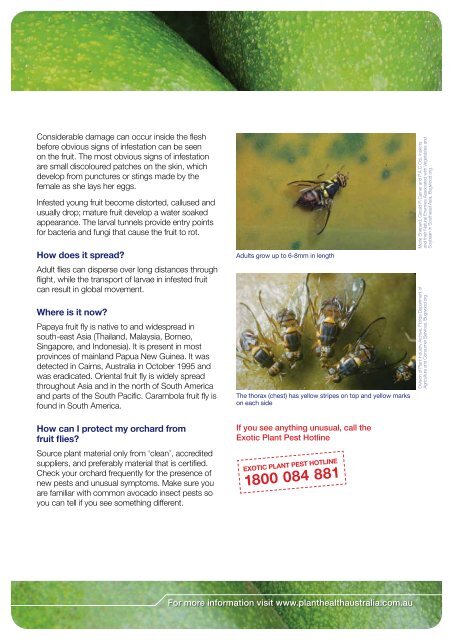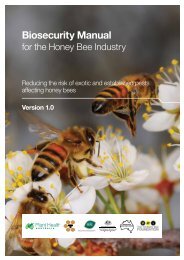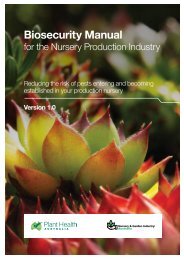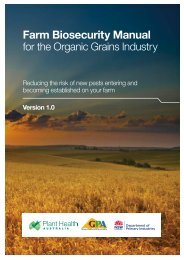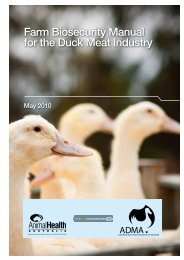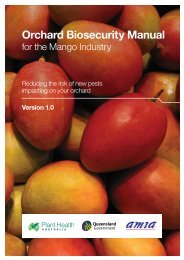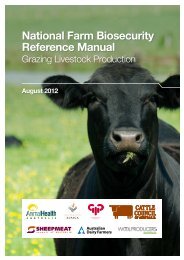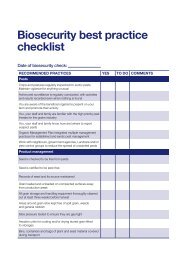Orchard Biosecurity Manual for the Avocado ... - Farm Biosecurity
Orchard Biosecurity Manual for the Avocado ... - Farm Biosecurity
Orchard Biosecurity Manual for the Avocado ... - Farm Biosecurity
You also want an ePaper? Increase the reach of your titles
YUMPU automatically turns print PDFs into web optimized ePapers that Google loves.
Considerable damage can occur inside <strong>the</strong> flesh<br />
be<strong>for</strong>e obvious signs of infestation can be seen<br />
on <strong>the</strong> fruit. The most obvious signs of infestation<br />
are small discoloured patches on <strong>the</strong> skin, which<br />
develop from punctures or stings made by <strong>the</strong><br />
female as she lays her eggs.<br />
Infested young fruit become distorted, callused and<br />
usually drop; mature fruit develop a water soaked<br />
appearance. The larval tunnels provide entry points<br />
<strong>for</strong> bacteria and fungi that cause <strong>the</strong> fruit to rot.<br />
How does it spread?<br />
Adult flies can disperse over long distances through<br />
flight, while <strong>the</strong> transport of larvae in infested fruit<br />
can result in global movement.<br />
Where is it now?<br />
Papaya fruit fly is native to and widespread in<br />
south-east Asia (Thailand, Malaysia, Borneo,<br />
Singapore, and Indonesia). It is present in most<br />
provinces of mainland Papua New Guinea. It was<br />
detected in Cairns, Australia in October 1995 and<br />
was eradicated. Oriental fruit fly is widely spread<br />
throughout Asia and in <strong>the</strong> north of South America<br />
and parts of <strong>the</strong> South Pacific. Carambola fruit fly is<br />
found in South America.<br />
How can I protect my orchard from<br />
fruit flies?<br />
Source plant material only from ‘clean’, accredited<br />
suppliers, and preferably material that is certified.<br />
Check your orchard frequently <strong>for</strong> <strong>the</strong> presence of<br />
new pests and unusual symptoms. Make sure you<br />
are familiar with common avocado insect pests so<br />
you can tell if you see something different.<br />
Adults grow up to 6-8mm in length<br />
The thorax (chest) has yellow stripes on top and yellow marks<br />
on each side<br />
If you see anything unusual, call <strong>the</strong><br />
Exotic Plant Pest Hotline<br />
EXOTIC PLANT PEST HOTLINE<br />
1800 084 881<br />
For more in<strong>for</strong>mation visit www.plan<strong>the</strong>althaustralia.com.au<br />
Merle Shepard, Gerald R.Carner and P.A.C Ooi, Insects<br />
and <strong>the</strong>ir Natural Enemies Associated with Vegetables and<br />
Soybean in Sou<strong>the</strong>ast Asia, Bugwood.org<br />
Division of Plant Industry Archive, Florida Department of<br />
Agriculture and Consumer Services, Bugwood.org


